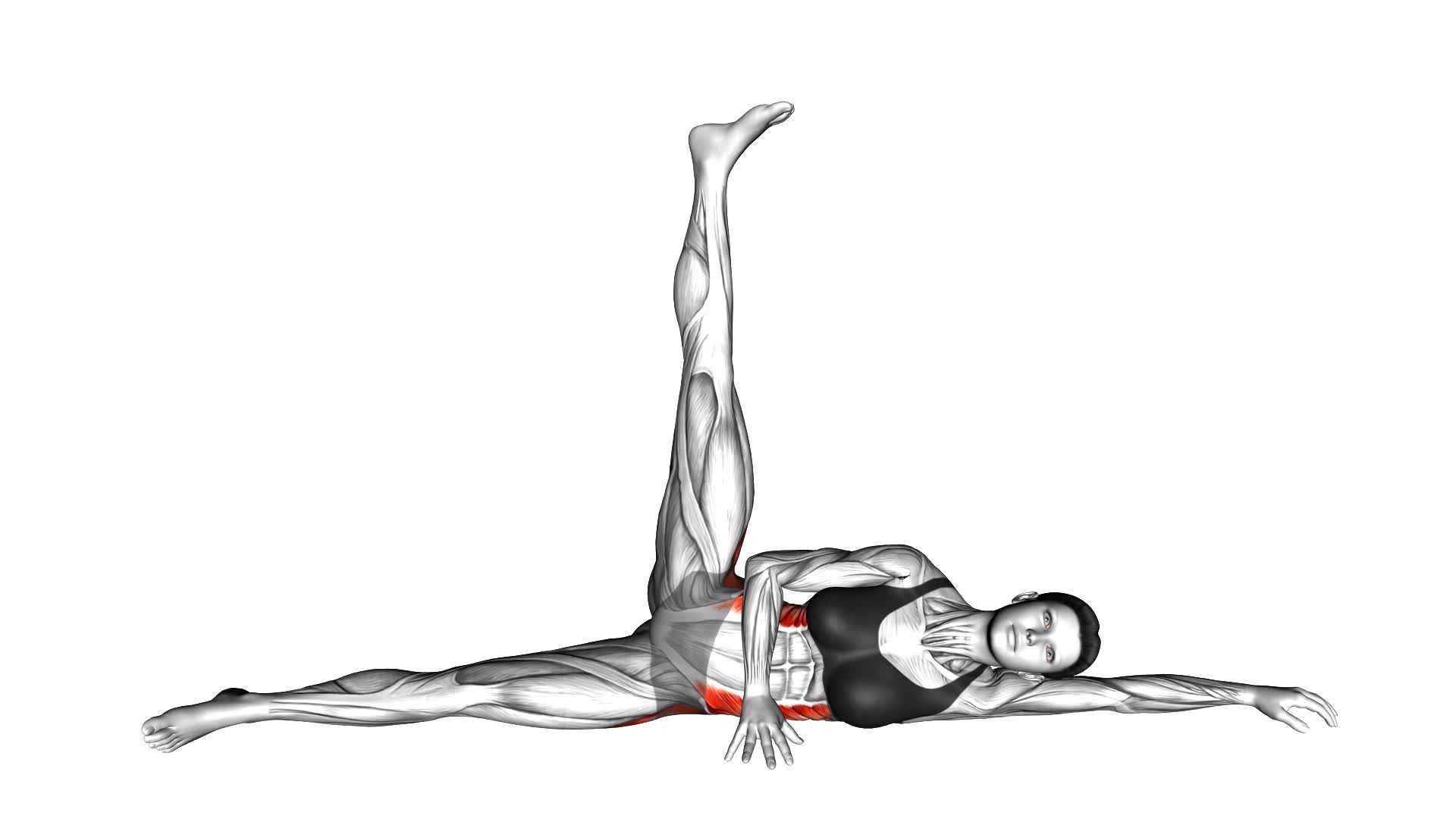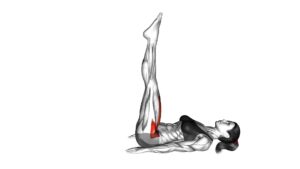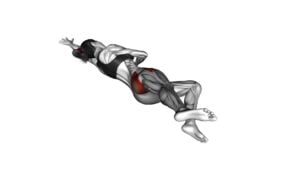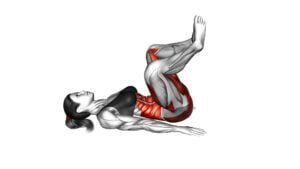Lying Full Leg Raise (Female) – Video Exercise Guide & Tips

Are you looking to strengthen your core and tone your legs? Look no further than the Lying Full Leg Raise exercise.
Watch This Exercise Video
In this video guide, we'll show you the proper form and technique, along with modifications for beginners and advanced variations for experienced individuals.
Avoid common mistakes and get the most out of your workout with our helpful tips.
Get ready to feel the burn and achieve your fitness goals with this effective exercise.
Key Takeaways
- The lying full leg raise improves flexibility in hamstrings and lower back, targets muscles in the lower abdomen, hips, and thighs, strengthens and tones core muscles, enhances posture and balance, and helps prevent lower back pain.
- Proper form and technique for the lying full leg raise includes lying flat on your back with legs extended and arms by your sides, engaging core muscles, keeping legs straight with toes pointed towards the ceiling, and avoiding using momentum or swinging legs.
- Modifications for beginners include starting by lifting one leg at a time, bending knees slightly to decrease the load on the lower back, gradually straightening legs for a more challenging workout, keeping track of repetitions and gradually increasing over time, and using a timer to track how long you can hold the raised position.
- Advanced variations for experienced individuals include the single leg raise, weighted leg raise, hanging leg raise, and bicycle leg raise. Each variation adds an extra challenge to the exercise.
Benefits of the Lying Full Leg Raise
To begin reaping the benefits of the Lying Full Leg Raise, start incorporating this exercise into your regular workout routine. This exercise is highly effective for improving flexibility and building core strength. When performed correctly, it targets the muscles in your lower abdomen, hips, and thighs, helping to strengthen and tone them.
One of the main benefits of the Lying Full Leg Raise is improved flexibility. As you lift your legs off the ground and raise them towards the ceiling, you stretch the muscles in your hamstrings and lower back. Over time, this can lead to increased flexibility and range of motion in these areas.
Another benefit is the strengthening of your core muscles. The Lying Full Leg Raise engages your abdominal muscles, including your rectus abdominis and obliques. By consistently performing this exercise, you can develop a stronger core, which is essential for maintaining proper posture, improving balance, and preventing lower back pain.
Incorporating the Lying Full Leg Raise into your workout routine can provide you with these significant benefits. Remember to start with proper form and gradually increase the difficulty as your strength improves. With consistency and dedication, you'll soon experience improved flexibility and a stronger core.
Proper Form and Technique
To perform the Lying Full Leg Raise with proper form and technique, follow these steps:
- Lie flat on your back with your legs extended and your arms by your sides.
- Engage your core muscles by pulling your belly button in towards your spine.
- Keep your legs straight and your toes pointed towards the ceiling.
- Slowly raise your legs off the ground, using your abdominal muscles to lift them.
- Avoid using momentum or swinging your legs to complete the movement.
Stretching is crucial before attempting the Lying Full Leg Raise. It helps to warm up your muscles and increase their flexibility, reducing the risk of injury.
Incorporating core strength exercises like this one into your fitness routine can improve your posture, stability, and overall physical performance.
Remember to start with a few repetitions and gradually increase the number as you become more comfortable and stronger. Pay attention to your body and stop if you experience any pain or discomfort.
With proper form and technique, the Lying Full Leg Raise can be an effective exercise to strengthen your core and improve your overall fitness level.
Modifications for Beginners
Looking to modify the Lying Full Leg Raise for beginners? No worries, there are a few modifications you can make to make it more manageable.
First, instead of lifting both legs at the same time, start by lifting one leg at a time. This reduces the demand on your core muscles and allows you to build strength gradually. As you feel more comfortable, you can progress to lifting both legs together.
Another modification is to bend your knees slightly when lifting your legs. This decreases the load on your lower back and makes the exercise easier to perform. As you gain strength and flexibility, you can gradually straighten your legs for a more challenging workout.
To track your progress, keep a record of the number of leg raises you can do and gradually increase the repetitions over time. You can also use a timer to track how long you can hold the raised position before lowering your legs.
Advanced Variations for Experienced Individuals
For experienced individuals, take your lying full leg raise to the next level with advanced variations. These advanced modifications and techniques will challenge your core strength and stability, helping you achieve even greater results.
Here are four advanced variations to incorporate into your workout routine:
- Single Leg Raise: Lift one leg off the ground while keeping the other leg straight and elevated. This variation increases the demand on your core muscles and improves balance.
- Weighted Leg Raise: Hold a dumbbell or kettlebell between your feet as you perform the leg raise. The added resistance increases the intensity of the exercise, targeting your lower abdominal muscles even more effectively.
- Hanging Leg Raise: Hang from a pull-up bar or use a captain's chair to suspend your body. From this position, raise your legs up towards the ceiling, engaging your entire core. This variation challenges your upper body strength and stability while targeting your lower abs.
- Bicycle Leg Raise: While performing the leg raise, twist your torso and touch your opposite elbow to your knee as it comes up. This dynamic movement engages not only your core muscles but also your obliques, providing a full-body challenge.
Incorporating these advanced variations into your lying full leg raise routine will help you push your limits and continue progressing towards your fitness goals. Remember to maintain proper form and listen to your body to prevent any injuries.
Common Mistakes to Avoid
Avoiding common mistakes is essential for maximizing the effectiveness of your lying full leg raise. When performing this exercise, it's important to pay attention to your form. One common mistake to avoid is swinging your legs. Instead, focus on using your abdominal muscles to lift your legs in a controlled manner. This will ensure that you're targeting the correct muscles and getting the most out of the exercise.
Another common mistake is lifting your legs too high. While it may be tempting to go for a full range of motion, lifting your legs too high can put unnecessary strain on your lower back. Instead, focus on lifting your legs until they're parallel to the floor, or slightly higher if you can maintain proper form.
It is also important to avoid using momentum to lift your legs. Using momentum takes away from the effectiveness of the exercise and can lead to injury. Instead, focus on using your abdominal muscles to lift and lower your legs slowly and controlled.
Tips for Getting the Most Out of Your Workout
To get the most out of your workout, it's crucial to focus on proper form. This ensures that you're targeting the correct muscles and reducing the risk of injury.
Additionally, incorporating a variety of exercises that target different muscle groups can help prevent plateaus and keep your workouts challenging.
Lastly, consistency is key – make sure to stick to a regular workout routine to see the best results.
Proper Form Importance
To maximize your workout results, focus on maintaining proper form throughout your lying full leg raises exercise. Proper form is essential for targeting the correct muscles and preventing injury. Here are some tips to help you maintain proper form and get the most out of your workout:
- Importance of alignment: Keep your body in a straight line from head to toe. Avoid arching your back or lifting your shoulders off the ground.
- Core engagement: Activate your core muscles by pulling your belly button towards your spine. This will help stabilize your body and increase the effectiveness of the exercise.
- Controlled movement: Move in a slow and controlled manner, focusing on using your abdominal muscles to lift your legs. Avoid swinging or using momentum.
- Breathing: Remember to breathe throughout the exercise. Inhale as you lower your legs and exhale as you lift them.
By following these tips, you can ensure proper form and make the most out of your lying full leg raises.
Now, let's move on to the next section and learn how to utilize varying exercises for a well-rounded workout routine.
Utilize Varying Exercises
Now let's delve into how you can maximize your workout by incorporating a variety of exercises into your routine.
One way to do this is by using different exercise equipment. By switching up the equipment you use, you can target different muscle groups and keep your workouts challenging and engaging. For example, you can alternate between using dumbbells, resistance bands, and kettlebells to work your upper body, lower body, and core.
Another way to vary your exercises is by combining different movements. Instead of sticking to traditional exercises like squats or bicep curls, try incorporating compound exercises that work multiple muscle groups at once. For instance, you can perform a squat with an overhead press or a lunge with a twist.
Stay Consistent for Results
To get the most out of your workout and achieve the results you desire, it's essential to stay consistent in your exercise routine. Consistency is important because it allows your body to adapt and improve over time.
Here are some tips to help you stay consistent and maximize your workout intensity:
- Set realistic goals: Define what you want to achieve and break it down into smaller, manageable goals.
- Create a schedule: Plan your workouts in advance and stick to them. Treat them as non-negotiable appointments.
- Find motivation: Identify what motivates you and use it to stay committed. Whether it's a workout buddy, music, or a reward system, find what works for you.
- Track your progress: Keep a record of your workouts, measurements, and how you feel. This will help you see your progress and stay motivated.
Frequently Asked Questions
What Are Some Alternative Exercises That Target the Same Muscle Groups as the Lying Full Leg Raise?
Looking for alternative exercises that target the same muscle groups as the lying full leg raise?
There are a few options you can try.
One is the hanging leg raise, where you hang from a bar and lift your legs up towards your chest.
Another option is the seated leg raise, where you sit on a bench and extend your legs straight out in front of you.
Both of these exercises can help strengthen your core and leg muscles.
Can the Lying Full Leg Raise Help Improve Flexibility?
Improving flexibility is one of the benefits of the lying full leg raise. By performing this exercise, you can increase the range of motion in your hip flexors and hamstrings. This can help you move more freely and prevent injuries.
The lying full leg raise specifically targets these muscle groups, making it an effective exercise for improving flexibility. Incorporating this exercise into your routine can lead to greater mobility and overall fitness.
How Many Reps and Sets Should I Do for the Lying Full Leg Raise?
To determine the number of reps and sets for the lying full leg raise, you should consider your fitness level and goals. Start with 2-3 sets of 8-12 reps, focusing on maintaining proper form and technique throughout.
As you become more comfortable and stronger, you can increase the number of sets or reps.
Additionally, you can incorporate variations of the lying full leg raise to challenge your muscles in different ways and further improve flexibility.
Is It Safe to Perform the Lying Full Leg Raise if I Have Lower Back Pain?
If you have lower back pain, it's important to be cautious when performing the lying full leg raise. There are modifications you can make to make it safer, such as bending your knees or using a stability ball.
Additionally, proper form and technique are crucial to prevent exacerbating your lower back pain. Engage your core and focus on keeping your lower back flat against the floor throughout the exercise.
Can the Lying Full Leg Raise Be Incorporated Into a Full-Body Workout Routine?
Yes, the lying full leg raise can definitely be incorporated into a full-body workout routine.
It offers numerous benefits such as strengthening the core, hip flexors, and lower abdominal muscles.
There are also variations of the lying full leg raise, like adding ankle weights or performing it on an incline bench, to make it more challenging.
Including this exercise in your routine can help improve overall strength and stability in your lower body.
Conclusion
In conclusion, the lying full leg raise is a beneficial exercise that targets the lower abdominal muscles and helps improve core strength. By following proper form and technique, beginners can gradually progress and eventually try advanced variations.
It's important to avoid common mistakes and focus on getting the most out of each workout. Incorporating this exercise into your fitness routine can lead to stronger and more defined abs.

Author
Years ago, the spark of my life’s passion ignited in my mind the moment I stepped into the local gym for the first time. The inaugural bead of perspiration, the initial endeavor, the very first surge of endorphins, and a sense of pride that washed over me post-workout marked the beginning of my deep-seated interest in strength sports, fitness, and sports nutrition. This very curiosity blossomed rapidly into a profound fascination, propelling me to earn a Master’s degree in Physical Education from the Academy of Physical Education in Krakow, followed by a Sports Manager diploma from the Jagiellonian University. My journey of growth led me to gain more specialized qualifications, such as being a certified personal trainer with a focus on sports dietetics, a lifeguard, and an instructor for wellness and corrective gymnastics. Theoretical knowledge paired seamlessly with practical experience, reinforcing my belief that the transformation of individuals under my guidance was also a reflection of my personal growth. This belief holds true even today. Each day, I strive to push the boundaries and explore new realms. These realms gently elevate me to greater heights. The unique combination of passion for my field and the continuous quest for growth fuels my drive to break new ground.







